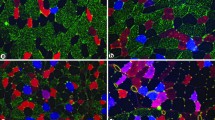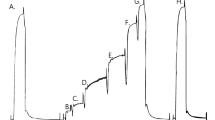Summary
Muscle biopsies were obtained from the anterior tibial muscle (TA) of 15 healthy, sedentary young (23–37 years) and 13 healthy and physically active elderly (66–77 years) volunteers. The mean frequency of type I fibres was lower in the young subjects compared with the elderly, but the mean type I fibre cross-sectional area was equal in the two groups. The type IIA fibres were, however, smaller in the elderly than in young subjects. Capillary density, capillary per fibre ratio, capillaries in contact with type I fibres (CC) and CC in relation to type I and type II fibre area did not differ in the two groups. The number of capillaries in contact with type IIA fibres was higher in the younger group. Only occasional and minor pathological changes were observed in the young subjects. In the elderly, such changes were much more common, including central nuclei, ring fibres, fibre splitting, scattered highly atrophic fibres, motheaten fibres and vacuoles. Ring fibres were most easily identified with anti-desmin labelling and highly atrophic fibres exhibited a rough network of labelling. Increased content of actin and spectrin was also observed at the periphery of ring fibres. In the elderly group, a qualitative ultrastructural analysis was also obtained and obvious changes included some myofilament loss, collections of lipofuscin which were also observed in satellite cells, proliferation of the SR-T systems and increased wrinkling of nuclear membranes and sarcolemma.
Similar content being viewed by others
References
Andersen P (1975) Capillary density in skeletal muscle of man. Acta Physiol Scand 95:203–205
Andersen P, Henriksson J (1977) Capillary supply of the quadriceps femoris muscle of man: adaptive response to exercise. J Physiol (Lond) 270:677–690
Borg J (1981) Properties of single motor units of the extensor digitorum brevis muscle in elderly humans. Muscle Nerve 4:429–434
Borg J, Edström L, Butler-Brown GS, Thornell LE (1987) Muscle fibre type composition, motoneurone firing properties, axonal conduction velocity and refractory period for foot extensor motor units in dystrophia myotonica. J Neurol Neurosurg Psychiatry 50:1036–1044
Brooke MH, Kaiser KK (1970) Muscle fiber types — How many and what kind? Arch Neurol 23:369–379
Campbell MJ, McComas AJ, Petito F (1973) Physiological changes in ageing muscles. J Neurol Neurosurg Psychiatry 36:174–182
Chou SM, Nonaka I (1977) Satellite cells and muscle regeneration in diseased human skeletal muscle. J Neurol Sci 34:131–145
Dubowitz V, Brooke MH (1973) Muscle biopsy: a modern approach. Saunders WB, Philadelphia, pp 34–102
Edström L, Larsson L (1987) Effects of age on contractile and enzyme histochemical properties of fast- and slow-twitch single motor units in the rat. J Physiol (Lond) 392:129–145
Edström L, Thornell LE, Albo J, Landin S, Samuelsson M (1990) Myopathy with respiratory failure and typical myofibrillar lesions. J Neurol Sci 96:211–228
Engel WK, Cunningham GC (1963) Rapid examination of muscle tissue: an improved trichrome method for fresh-frozen sections. Neurology 13:919
Fujisawa K (1974) Some observations on the skeletal musculature of aged rats. Part 1. Histological aspects. J Neurol Sci 22:353–366
Fujisawa K (1975) Some observations on the skeletal musculature of aged rats. Part 2. Fine morphology of diseased muscle fibres. J Neurol Sci 24:447–469
Greenfield JG, Shy GM, Alvond EC Jr, Berg L (1957) An Atlas of Muscle Pathology. In: Neuromuscular diseases. Livingstone, Edinburgh
Grimby L (1984) Firing properties of single human motor units during locomotion. J Physiol (Lond) 346:195–202
Gutman E, Hanzlikova V (1972) Age changes in the neuromuscular system. Scientechnica, Bristol, pp 34–35
Henriksson EG (1979) “Semi-open” muscle biopsy technique. A simple outpatient procedure. Acta Neurol Scand 59:317–323
Hermansen L, Wachtlowa M (1971) Capillary density of skeletal muscle in well-trained and untrained men. J Appl Physiol 30:860–863
Ingjer F (1979) Effects of endurance training on muscle fibre ATP-ase activity, capillary supply and mitochondrial content in man. J Physiol (Lond) 294:419–422
Jakobsson F, Borg K, Edström L, Grimby L (1988) Use of motor units in relation to muscle fiber type and size in man. Muscle Nerve 11:1211–1219
Jennekens FGI, Tomlinson BE, Walton IN (1971) Histochemical aspects of fine limb muscles in old age. An autopsy study. J Neurol Sci 14:259–276
Larsson L, Edström L (1986) Effects of age on enzyme-histochemical fibre spectra and contractile properties of fast- and slow-twich skeletal muscles in the rat. J Neurol Sci 76:69–89
Larsson L, Sjödin B, Karlsson J (1978) Histochemical and biochemical changes in human skeletal muscle with age in sedentary males, age 22–65 years. Acta Physiol Scand 103:31–39
Lindholm T (1968) The influence of uraemia and electrolyte disturbances on muscle action potentials and motor nerve conduction in man. Acta Med Scand [Suppl] 491:13–14
Padykula HA, Herman E (1955) The specificity of the histochemical method for adenosine triphosphatase. J Histochem Cytochem 3:170–183
Petersén I, Kugelberg E (1949) Duration and form of action potential in the normal human muscle. J Neurol Neurosurg Psychiatry 12:124–128
Poggi P, Marchetti C, Scelsi R (1987) Automatic morphometric analysis of skeletal muscle fibers in the ageing man. Anat Rev 217:30–34
Radner S (1962) Knappnålsteknik för iterativ muskelbiopsi. Trans Swedish Soc Med Sci XIX:94
Scelsi R, Marchetti C, Poggi P (1980) Histochemical and ultrastructural aspects of m. vastus lateralis in sedentary old people (age 65–89 years). Acta Neuropathol (Berl) 5:99–105
Schantz P (1983) Capillary supply in heavy resistance trained non-postural human skeletal muscle. Acta Physiol Scand 117:153–155
Thiele B, Stålberg E (1975) Single fibre EMG findings in polyneuropathies of different aetiology. J Neurol Neurosurg Psychiatry 38:881–887
Thornell LE, Eriksson A, Edström L (1983) Intermediate filaments in human myopathies. Cell Muscle Motil 4:85–136
Tomé FMS, Fardeau M (1986) Nuclear changes in muscle disorders. Methods Achiev Exp Pathol 12:261–296
Tomonaga M (1984) Histochemical and ultrastructural changes in senile human skeletal muscle. J Am Geriatr Soc 25:125–131
Virtanen J, Kallajock M, Nävänen O, Paranko J, Thornell LE, Miettinen M, Letho V (1986) Pertubular myoid cells of human and rat testis are smooth muscle cells that contain desmin-type intermediate filaments. Anat Rec 215:10–20
Author information
Authors and Affiliations
Additional information
Supported by grants from the Swedish Medical Research Council (B89-12X-03875-13C), the Swedish Sports Research Council, the King Gustaf Vth Research Foundation, the Norrbacka-Eugenia Foundation, the Swedish Medical Society, the MS Foundation and the Karolinska Institute
Rights and permissions
About this article
Cite this article
Jakobsson, F., Borg, K. & Edström, L. Fibre-type composition, structure and cytoskeletal protein location of fibres in anterior tibial muscle. Acta Neuropathol 80, 459–468 (1990). https://doi.org/10.1007/BF00294604
Received:
Accepted:
Issue Date:
DOI: https://doi.org/10.1007/BF00294604




